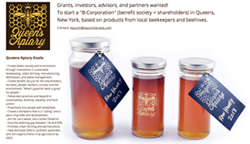It is wonderful to see them outside the window from our kitchen/dining room, busily flying in and out of the hive every day.
The first inspection was done on May 26. Here’s the video from the inspection.
The bees had begun building a comb around the queen cage, locking what seemed like some worker bees inside. At least, the queen was alive and we’re hoping she will begin laying eggs in time for the hive to keep going.
At the end of the inspection, the kids from the building across our roof, saw the inspection, and started yelling out questions from their window.
Phil, our beekeeper, and his girlfriend spontaneously responded to their questions. I’ve included the transcript of their Q&A session below the video.
Q&A between neighborhood kids and beekeepers
Q: What do they eat?
A: They eat pollen from plants and flowers
Q: From where?
A: All over…They can travel a really long time…They fly about 2 miles
and then they come back with pollen…They know this is their
home…They live here.
Q: Where did you get them?
A: From Georgia
Q: Can we see the bees flying?
A: Yes, they are everywhere!
Q: What’s that blue thing?
A: It’s the lid – the roof of their home…This is where they live…
Q: Do they have a bed? They sleep on the wings?
A: No, they make a home inside.They make little rooms for themselves called honeycombs. This is where they sleep. (correction: Bees don’t sleep.) It’s their house.
Q: Why are there many bees [around the entrance]?
A: Because they are going to get more food…Those are the awake bees.
Q: What’s that in your hand?
A: It’s the brush – so I can sweep the bees – if they are on me.
Q: Why?
A: Because they can sting you! and you don’t want that! But these are nice bees. They won’t sting you unless you are breaking into their house, like
we just did!!!
Q: How do they get in?
A: There’s a little door! It’s only big enough for one bee! (for now)…They fly out all the time
Q: Are there any ants?
A: No ants. The bees would kill them. Only bees.
=================
The first batch of flower seeds were planted in flats on May 30.
Thanks for all your support, and stay tuned!



